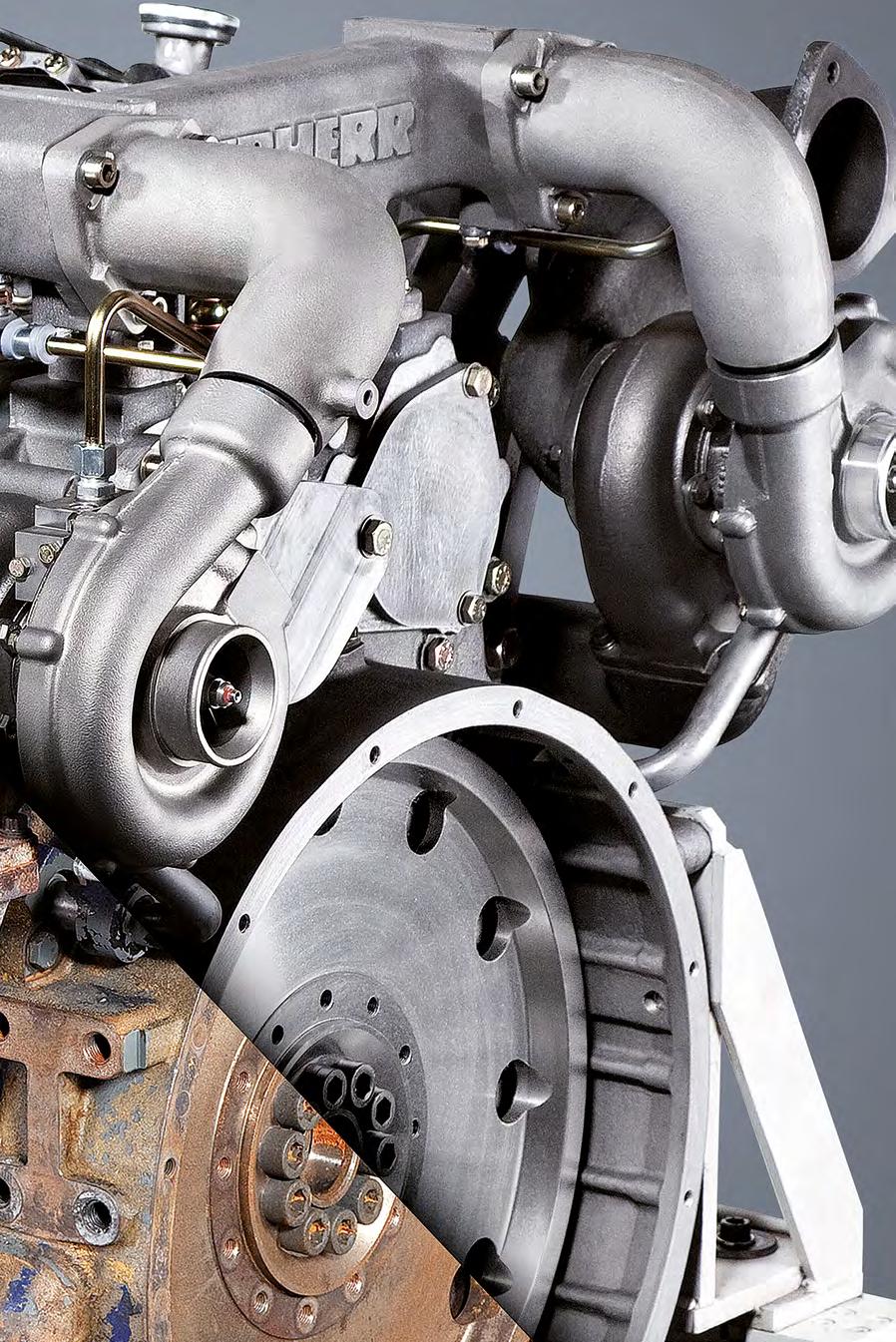
59 minute read
OUTLOOK
OUTLOOK
Digitalisation
Advertisement
Digitalisation has been very much in vogue in recent years and has not spared the machinery industry. Here, this term is understood to mean the increasing use of information technology and connected devices and components to enable the precise monitoring of processes on a production line. The Swedish company Volvo Construction Equipment has embraced digitalisation, integrating a host of sensors into its construction machinery to optimise fuel consumption and truck loading, but also so that it can continually monitor the overall condition of its machinery to prevent breakdowns and facilitate repairs when they become necessary. These innovations reduce part breakages and replacements and therefore consumption of primary raw materials. Digitalisation has huge development potential and can greatly benefit the circular economy, ensuring more efficient use of primary raw materials and a reduction in the quantities used.
Selling use rather than ownership
Today, many businesses are taking the plunge and changing their business model: selling the use instead of the ownership of their product. There is actually nothing new about this idea. As early as 1962, the British aircraft engine manufacturer Rolls-Royce launched its Power by the hour scheme, a comprehensive service based on flying hours that included the engine and replacement parts, charged at a set hourly fee. Today, Rolls-Royce is again offering this service, which has become the industry norm. This business model serves the interests of both parties, which is that the product functions correctly. It is in the manufacturer’s interests that its product should work properly because this reduces its labour and materials costs, while the customer benefits from the fact that the product functions continuously.
CORINNE GRÄSSLE Circular Economy Project Leader, Engagement Migros
The circular economy is a central element of a sustainable economy because it enables us to produce and consume intelligently while saving resources.
Spotlight on …
LIEBHERR
Founded in 1949 with the tower crane as its flagship product, Liebherr is today a multinational company operating in a large number of sectors, including construction machinery. Manufacturing these products consumes a large quantity of raw materials, and Liebherr has introduced an innovative solution to extend the useful life of its machinery: Liebherr Reman. This programme offers customers a remanufacturing (reconditioning) service for key components such as motors, travel drives, swivelling drives and axles, along with other eligible components. To ensure efficient customer service, Liebherr has plants around the world with the facilities to remanufacture these components. The resulting savings in energy and materials can be as much as 75%.
Spotlight on …
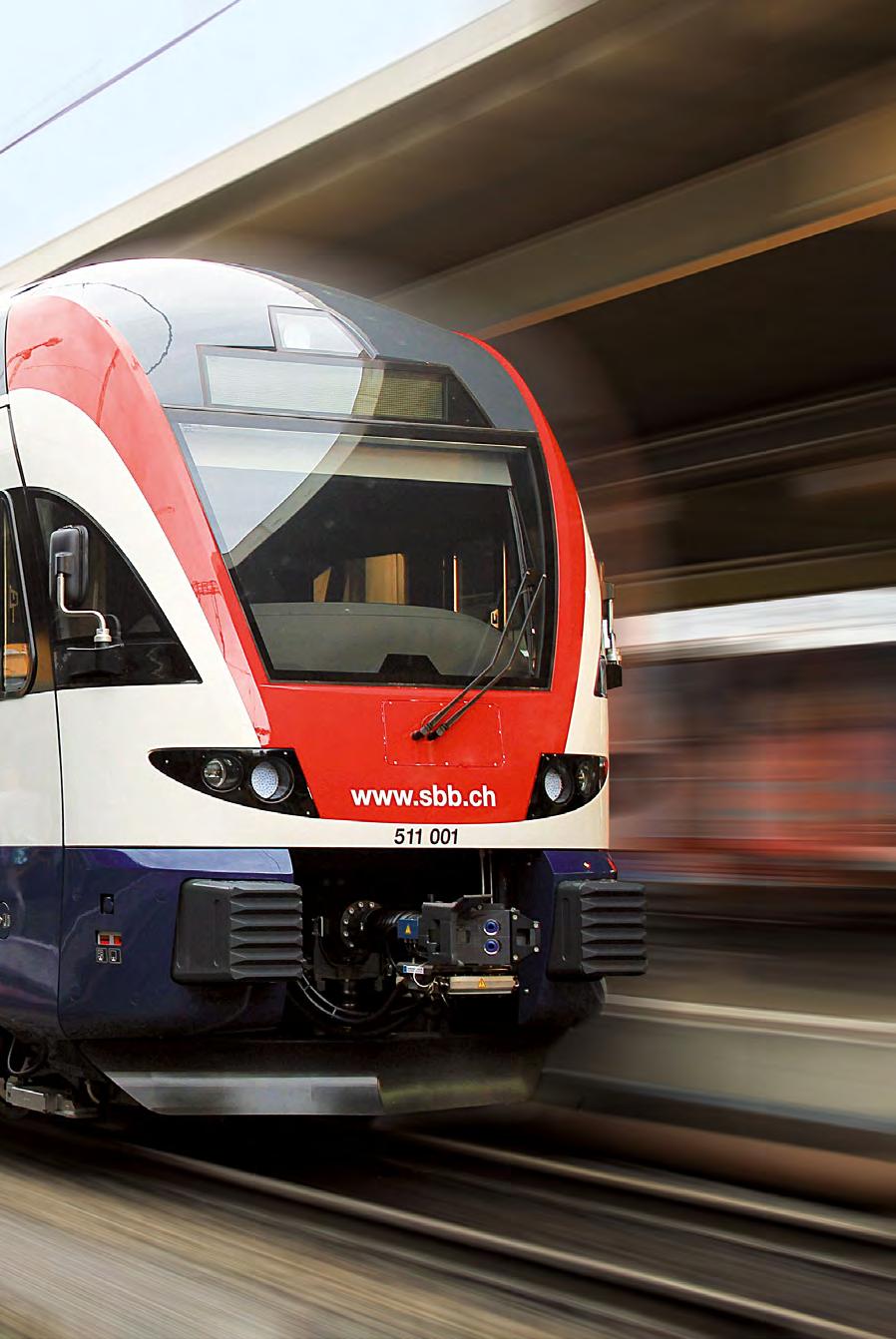
STADLER RAIL
Based in Bussnang, eastern Switzerland, Stadler Rail AG is a manufacturer of railway rolling stock essentially active on the regional and suburban trains market. For some years, the company has placed the life cycle of its product at the heart of its strategy. Stadler Rail’s engineers are given the job of designing train components that do not use mixed materials, to simplify the disassembly and recycling of its rolling stock when it reaches the end of its use phase. The resulting recycled materials can easily be re-used. In 2019, Stadler Rail published an Environmental Product Declaration for one of its products (the KISS), detailing its overall environmental impact throughout its life cycle and its recycling potential (97.9%).
LUXURY GOODS AND WATCHMAKING
The luxury goods industry, understood here to include fashion, jewellery and watchmaking, is made up mainly of large international groups such as LVMH, Kering, Richemont and Swatch Group, but also private groups such as Hermès, Rolex and Patek Philippe. Although the LVMH, Kering and Hermès groups are registered in France, a large part of their watchmaking and jewellery business is based in Switzerland.
The luxury goods industry has a major impact on the environment73, largely due to the vast quantity of primary raw materials, precious metals and leather it consume74. WWF estimates that more than half of the gold extracted every year, more than 2,000 tonnes, is consumed by the jewellery and watchmaking industries75. In addition to the product itself, in the luxury goods market, an important part the customer experience is the packaging, which can account for a significant proportion of the industry’s environmental impact76 .
Under growing pressure from millennials, the generation born between the early 1980s and the mid-1990s, the luxury goods industry is slowly moving towards circular economy practices. One study estimates that millennials will represent 50% of the customer base of luxury goods brands in 2025 (up from 32% in 2018) and will generate growth of 130% in the market between 2018 and 202577. To meet the new expectations of consumers, the luxury goods industry is innovating in the three specific areas outlined below.
Supply
World leader LVMH has launched a ‘materials library’, an in-house database for its designers that lists more than 300 environmentally friendly materials suitable for use in luxury goods78. Several other jewellery and watch brands are looking into replacing ‘standard’ gold with ‘sustainable’ gold, which is extracted under conditions that are more environmentally friendly and ensure higher welfare standards for local workers. They are also considering using recycled gold, for which end customers are so far showing little enthusiasm.
Ecodesign
In 2018, the luxury watchmaker Baume et Mercier, owned by the Richemont group, launched the eco-friendly Baume brand, which uses no precious metals or materials of animal origin79. Baume is the group’s experimental brand, using recycled or easily recyclable materials such as aluminium and going down the repairability route, which includes choosing a Japanese movement over a Swiss one.
Limiting the volume of waste and introducing re-use
The leather goods manufacturer Hermès has taken a different approach with the creation in 2010 of its brand petit h, whose products are made from textile offcuts or materials that are not used or marketed by the prestigious Hermès brand.
The discreet world of luxury goods is making progress step by step (under duress?) and somewhat haphazardly, adopting targeted measures without having an overall vision for its value chain. The choices made by groups headquartered abroad will impact their Swiss subsidiaries and perhaps give Swiss decision-makers, who are lagging behind, a nudge towards adopting circular economy practices.
FINANCE
Many businesses are developing circular strategies and others are transforming their business model to incorporate the principles of the more environmentally friendly circular economy. To encourage development to reach the next level, businesses need to invest. This is where the financial sector comes in.
Support from the finance sector for the circular economy is a fairly new thing. The Ellen MacArthur Foundation recently published a paper in which it refers to the lack of financial instruments related to the circular economy. In 2020, three investment funds worldwide were dedicated solely to the circular economy (there were two in 2019 and one in 2018). To grow, the circular economy needs funding that supports businesses by enabling them to adapt their business model and put in place circular strategies all along their value chain.
This point is a critical one in the view of some experts, because risk analysis models are not always calibrated for the circular economy80. For example, a company with a business model for selling washing machines then decides to sell the use of the machines rather than the machines themselves. As a result, it will have a different revenue collection model. Its revenue will be distributed over a longer time frame, and from the point of view of the credit organisation, this business model will be slower to make a profit and the necessary financing might be perceived to be higher risk.
Despite these challenges, investors are showing increasing interest and some of the banks are getting involved, developing innovative solutions to support the circular economy.
Investment funds that support the circular economy
In 2018, the Geneva-based finance industry pioneer DECALIA Asset Management launched DECALIA Circular Economy, an equity fund dedicated entirely to the circular economy81. The fund universe comprises almost 600 companies, mostly located in the United States, Europe and Japan and all of which have circular economy business models and/or strategies82. This type of instrument is helpful because it enables individual investors to invest and therefore support circular economy companies without having to seek them out and analyse them in detail, since the fund manager does that on their behalf. Switzerland is keeping pace. In October 2020, Banque Cantonale Vaudoise teamed up with CONINCO Explorers in finance SA to launch a ‘Certificat Tracker AMC EcoCircularity’ investment certificate for the circular economy (see box opposite).
Finance to support circular investment
Just like any other business, a business with a circular business model or circular strategies needs finance. A growing number of financial organisations are offering loans to support the circular economy. Banks like Intesa Sanpaolo (Italy) and publicly owned financial institutions such as the European Investment Bank (in partnerships with five of Europe’s biggest banks) have made available lines of credit of a value of five and 10 billion euros respectively to finance projects related to the circular economy83. In Switzerland, the Olten-based Alternative Bank Switzerland has a business model tailored to supporting alternative projects that foster the expansion of the circular economy84 .
BCV – Certificat Tracker AMC EcoCircularity
The strategy of this investment certificate is based on the elements of ecodesign, the industrial ecology and the economy of functionality.
The circular economy model is relevant to companies that achieve value creation with a positive environmental and social impact, cost savings and better management of raw materials requirements.
The companies considered can continue to invest during a period of crisis and consequently maintain or even increase their market share with respect to their competitors.
TOURISM
Tourism is the biggest single industry on the planet, accounting for more than 10% of the world’s GDP85. In Switzerland, it generated 2.9% of the country’s national wealth in 201986. The pressure that mass tourism exerts on the environment is growing along with the number of tourists; its consequences are damaging our ecosystems, biodiversity and air quality87. Despite its importance to the economy and impact on the environment, we rarely hear talk of ‘circular tourism’, but more often of ‘sustainable tourism’. According to the World Tourism Organization, sustainable tourism includes an environmental, economic and social dimension while addressing the needs of visitors, the industry, the environment and host communities88 .
Many tourists to Switzerland go there first and foremost for the scenery89, and since 1966 the country has had a law that protects nature and the landscape90. Nevertheless, the pressure on the environment is not easing and Switzerland’s countryside is being used increasingly for leisure and tourism purposes91. This is often blamed on the number of tourists, but industry professionals bear some of the responsibility. An unprecedented study analysing the life cycle of the Accor group’s hotels shows that more than 80% of their impact on water consumption is created by the kitchens and the water supply provided to customers92,93 . All the industry players are concerned by the impact of tourism on the environment, and many of them are working to preserve the environment, like the Swiss Alpine Club, whose statutes dating from 1907 refer explicitly to 'protecting beauty' and the 'struggle against the desecration of the high mountains', and whose communication is focused on the environment.
Tourists too are becoming increasingly aware of their impact on the environment and often look for more sustainable tourism options. To meet this growing demand, a number of labels have been created in recent years for the hospitality sector. Tourism concerns everyone, and Switzerland is at the forefront of sustainable tourism. Many initiatives are springing up, and tourists looking for somewhere to get away from it all and enjoy beautiful scenery are often receptive to new ideas.
DOMINIQUE GRUHL BEGIN Head of Start-ups and Next-Generation Innovators Division
Businesses with sustainable strategies are more agile and resilient. They have adopted a future-proof business model which anticipates increasing demands from consumers and any new legislation.
Spotlight on …

OONA CAVIAR AND TROPENHAUS FRUTIGEN
In an original business model, the mixed commercial and tourism site Tropenhaus Frutigen in the canton of Bern was developed after the Lötschberg railway tunnel opened. Because it cuts through the mountain, this tunnel prevents water from percolating down through the rock. Fifty litres of water at a temperature of 18°C flow out of the tunnel every second. The water is too warm to be fed into the River Entschlige and cooling it would consume too much energy. It was decided to use the water to farm sturgeon to produce the Swiss caviar Oona, and also to heat a hothouse for tropical plants. The water cools naturally as it goes through this process and is then fed into the river. The company has also developed a tourism attraction concept as part of the business, which is unique in Switzerland.
Experts views
As we have seen in the previous pages, the circular economy is a vast subject. To open up the debate and the range of possibilities even wider, we talked to five figures working in different industries and fields. They are all active in areas directly related to the circular economy, and here they give us their views on the subject.
3 questions for ...
DANIEL BAILLIFARD
Chief executive SATOM SA
For several years, SATOM has been running a number of projects as part of its circular economy approach. Where are you at the moment in this process?
SATOM SA’s vision is to constantly innovate to recover materials, produce clean energy and preserve the environment. This vision is an integral part of the circular economy mindset that lies at the heart of everything we do at SATOM SA. We’ve secured a lot of investment, including the recent launch of the Ecotube project to build a steam pipeline between the Monthey chemicals site and SATOM SA and a pilot project to produce hydrogen from waste. But there is still masses of potential, and we’re looking into lots of other projects. As a public service company owned by the public authorities, our role is to stay ahead of the game, identifying the right projects and spotting the changes in society and technology that will shape tomorrow’s world.
Which sector of the waste industry is the hardest to integrate into a circular economy approach, and why?
Currently, incinerator residue, or slag, is impossible to exploit fully. In recent years, huge progress has been made in recovering the metals it contains (around 11%), but it is still very difficult, or even impossible, to recover the mineral fraction because of both the very stringent environmental requirements laid down by the law and the low market demand for this recycled material. In the Energy-from-Waste sector, the medium-term objective is to recycle all of this part of the waste, which on average accounts for 15% of the total weight of the heat-generating waste and which currently ends up as type D landfill. Which cleantech technologies are the most promising for waste recovery?
CCS (carbon capture and storage) could be useful in the medium term in reducing or even eliminating the emissions that our Energy-from-Waste plants currently produce. The capture part of this technology is technically feasible, but CCS is not yet mature when it comes to the transport and permanent storage of the CO2. For this, Switzerland still needs to make changes to the legal framework and negotiate international agreements.
The rapidly developing technologies that use AI to identify objects are also set to revolutionise the waste processing industry. Ultra-efficient automated waste sorting centres connected to our Energy-from-Waste plants will be capable of sorting all of the fractions that can be recovered both upstream and downstream of the processing chain, putting waste as a resource at the heart of a sustainable circular economy.
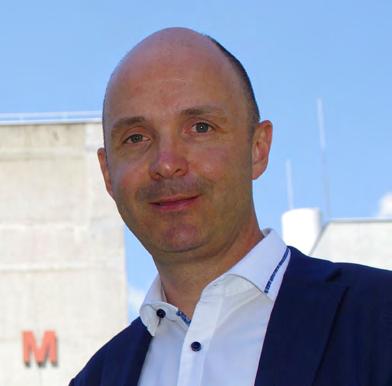
3 questions for...
ALEXIA DUFOUR
The Canton of Geneva has been a circular economy pioneer in Switzerland, with the « Genie.ch » portal for example. What impact has this initiative had?
Executive assistant with responsibility for cross-sector integration of environmental policy Environmental protection office for the State of Geneva (OCEV)
Genie.ch is the first business social media forum designed to develop industrial ecology and more broadly the circular economy. It’s a collaborative platform that provides projects, ideas, workshops on different topics, daily news updates and examples of good practice that combine economic performance with respect for the environment. We launched it in 2015, and it now has a thousand members who deal with most of the issues affecting our local area. It’s a recognised brand, which helps raise awareness and facilitate discussion. To enhance its impact even more and boost the network, it is now looking to step up its public-private partnerships with a view to helping Geneva businesses adapt to the circular economy and deal with challenges of the ecological transition. What instruments might enable the economy to move towards a more sustainable model?
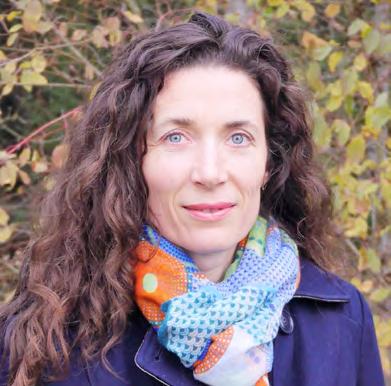
The COVID crisis has demonstrated the importance of controlling the value chain and of short circuits. Does the circular economy provide an answer to these challenges?
Yes, of course it does. The circular economy is inspired by natural ecosystems in which nothing is wasted, nothing is created, and everything is transformed. To close materials cycles, slow them down, minimise the use of resources and non-renewable energy and reduce waste generation, it seeks to develop local trade networks and interactions between the players within a given territory. This makes it a tremendous lever for relocalising economic flows, developing a more local and more sustainable economy and meeting the challenges of controlling the value chain and creating short circuits that have been thrown up by the current health emergency.
The way to achieve this transition is through experimentation and innovative projects. To help the economic players with this kind of approach, we need to find ways of covering the risks inherent in any innovation, help them make the change and facilitate cross-sector approaches. Lastly, we need to do away with the ‘niche’ mindset, because this will enable us to accelerate and generalise the practical application of the circular approach. To that end, central government has a key role to play in setting the framework conditions, for example in terms of standards, tax incentives and even subsidies.
5 questions for...
ANDRÉ HOFFMANN
Initiator of the Circular Economy Switzerland movement and President of MAVA Foundation
Who can take part in the Circular Economy Switzerland movement?
The original idea was to promote the circular economy among both small and large businesses in Switzerland, so in principle everyone is welcome. There’s a brief tutorial a few pages long which gets shared around, and the people who embrace the ideas in this tutorial can help us progress the concept.
What about a business that hasn’t yet incorporated circularity operationally? Can it also take part?
With Switzerland having one of the highest per-capita GDPs in the world and a very high standard of living, the quantity of waste produced per person is huge. This being the case, how can we conceive a transition to a waste-free economy? I think, in Switzerland, the way to make sure we can create a circular economy is by using more technology. With the incubator [The Ark] for example, in Valais we have the option of using more technology to make products that are better integrated within the circular economy, which may not be possible elsewhere. And I think that’s an advantage we should use. We have a smaller, very efficient system that makes it possible to introduce this concept. So in my opinion, this initiative, Absolutely! The idea is to bring about a real change of supported by MAVA, is about trying to create a prototype mindset in Swiss businesses and to try to introduce these system than can be replicated by other countries in circularity concepts right from the start. As you know Europe and around the world. better than me, the basic principle of the circular economy is to go beyond Bringing about a change of mindset in Swiss the primary uses of a businesses and trying to introduce circularity product by incorporating its re-use as a next step. concepts right from the start This does of course require a change in thinking by businesses that will only work if it’s addressed in advance. It’s not about saying, 'oh dear, I produce waste, I must do something with it,' it’s about Do you think Switzerland is agile enough to succeed in a transition of this kind? making sure that the waste is re-usable at the project conception stage. There are three things to bear in mind about Switzerland. Firstly, we have some excellent universities capable of developing technologies to facilitate this transition. Secondly, we have the fact that our economy is dependent on imported resources. In Switzerland, we
don’t have any natural resources we can use, except for glacial meltwater perhaps. And that has encouraged us to develop more efficient production methods right from the start. That’s something we should make more of. Thirdly, the majority of Swiss businesses have been making changes to reduce their ecological footprint. It seems that, in Switzerland, we have integrated these sustainable economy concepts in our practices more readily than in other countries. Switzerland, with its small volumes and high standards, is a very good place to undertake a transition of this kind.
How can we make this transition to the circular economy while remaining profitable?
There are two determining factors here: the time factor and the profitability factor. In my value generation equation, I have to look at which costs I can put off until later and which costs I take on today. You have to find the right balance of course, because a business that is not profitable becomes a problem. If you want to create a business that is sustainable in the long term, you must take into account not only what will happen in the following generations but also what is happening in terms of the use of resources now. In my opinion, running a business involves two essential tasks, backed up by a whole series of skills and areas of expertise: resource allocation and risk management. Today, the risk that a business will fail based on the current model is greater than it has ever been. The pandemic has made that quite clear: we are weak, a giant with feet of clay. To make sure we can meet society’s needs in the future, we have to think about how to manage that risk. In terms of resource allocation, this means not everything ‘right now’ but much of it over the long term.
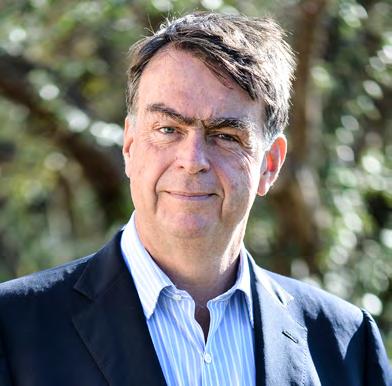
Joint interview: the circular economy strategy and practices of Nespresso
To what extent is the circular economy a strategic element for Nespresso’s economic growth?
Christophe Boussemart (C.B.): The founding principles of the circular economy (see page 10) are strategic for Nespresso because we depend on resilient ecosystems for our coffee and on finite resources and we want to continue selling our products. It is therefore important, necessary and fundamental that Nespresso should contribute to the circular economy.
Alban Bitz (A.B.): The coffee that forms the basis of Nespresso’s product is an organic element, and therefore by its nature it can return to the earth in a virtuous circle. To a certain extent, the aluminium and cardboard used in its packaging – even though they are processed – can be re-used. This demands a circular approach as much from an environmental point of view as an economic one. As a result, circularity is a strategic element for Nespresso.
How do you apply this circular economy strategy throughout your value chain?
C.B.: Firstly, by preserving the ecosystems in the regions where we buy the coffee by applying principles of sustainable cultivation (the principles defined with the NGO Rainforest Alliance) and the principles of agroforestry. Then, by using circular materials like aluminium, introducing capsule collection systems, recycling the aluminium and converting the coffee grounds into biogas. At Nespresso, we recently began using recycled aluminium to make our capsules. This has enabled us to complete the circular economy virtuous circle.
All of these actions contribute to the circularity of our current products, and it’s now up to us to develop new products and new business models to distribute these products. What advice would you give businesses about developing profitable circular business models?
C.B.: The circular economy fundamentally changes your way of thinking and doing business. Since the dawn of time, we’ve always been ‘linear’ in the way we use resources. What businesses need to do now is acquire people whose mindset is focused on one single idea: the circularity of resources. It’s also important for companies to develop and test new circular business models and accept that they’re not always going to get them right first time.
A. B.: I completely agree. You have to take the circular economy seriously, coming up with a strategic approach and working with competent, motivated people to develop these models. I would add that you also have to think of the circular economy as a unique opportunity to combine economic profitability with doing your bit to deal with the colossal challenges we are facing: the increasing scarcity of resources and climate change.
What is the consumer’s role from a circular economy perspective?
C.B.: The consumer’s role is fundamental. It’s the consumer who decides the future of the products he or she ‘owns’. The consumer can, as it were, ‘force’ companies to develop circular products, and product recycling is partly a result of consumers boycotting products that are non-recyclable.
A.B.: A very important role. Ultimately, it’s the consumer who acts and who can change everything through the act of the purchase. Unfortunately, at the moment it’s very difficult for consumers to know what’s what and make informed choices.

CHRISTOPHE BOUSSEMART
Sustainability Technology Manager NESTLÉ NESPRESSO Do you think that the market leaders have a particular responsibility to bring about a change of model more generally?
C.B.: Of course. As the market leader, a brand must lead by example. A brand must use its financial resources to invest in developing circular business models, explaining them to the consumer and ensuring they are accepted by the consumer.
A.B.: I agree. The market leaders have a huge responsibility. What’s more, it’s up to them to make this change all the way along their value chain. The worldwide economic fabric is made up mainly of SMEs and not multinationals, and these SMEs don’t necessarily have the same weapons with which to face these challenges.
In your opinion, what are the main obstacles to or restraints on the circular economy?
C.B.: Circular economy models have a tendency to generate revenue that is regular but lower and over a long period, unlike the linear economy, which generates higher revenue but all in one go. You have to cope with that accounting change and accept that you’ll earn the same amount but over a longer time span. You also have to take the plunge and accept that you may not succeed on your first attempt
A.B.: Short-term profit, because circular economy business models do not follow the standard procedures. You have to find the resources you need to be able to break out of the usual way to do things. In well-established organisations, that is often the biggest challenge. In your view and experience, in what way(s) is it possible to take the circular economy further?
C.B.: We have to start right now integrating the circular economy in new developments. In our case for example, our assets are currently mostly linear. What I mean by that is that we have invested a lot in linear infrastructures and models and we can’t simply scrub our existing set-up and change our model. To take the circular economy further, we therefore need to integrate these circular economy principles, but without making them run counter to what we already have. Instead, we need to reconcile these two models so that, in the long run, circularity comes out on top in the business world.
A.B.: In addition, I think there are three key elements that will accelerate the transition to a more circular economy. Firstly, it is often said that 80% of the impact occurs during the design stage of a product or service. So we have to ask ourselves the right questions at the right time, at the very start. Then, looking at the human aspect, it is very important to collaborate and build together. The circular economy makes it easier to create synergies. They might take place between two departments in the same business, or at regional level, to create ambitious projects involving multiple players, such as energy supply or turning one company’s waste into another’s resource. The third element is sharing good practice, and that isn’t yet happening enough. Which is of course one of the aims of this report.
Summary
This special report clearly shows that the circular economy is of growing interest around the world and in particular in Europe. Switzerland has focused on recycling and waste management, becoming one of the leading global players in these areas. But the circular economy is not simply about recycling. Breaking out of the linear economy, transforming our business models and modes of consumption and keeping products and components in the economic system for as long as possible are the true challenges of the circular economy. And if we are to succeed, we have much work still to do and many improvements yet to make.
In the food production industry for example, the shift towards the circular economy has begun, but it remains too tentative. It has the opportunity to benefit from Swiss expertise in regenerative agriculture, agroforestry and recyclable/re-usable packaging. More can also be done in the sustainable re-use of by-products of the various food production sectors.
Switzerland’s construction industry is already firmly rooted in the circular economy. It can also count on some promising innovations, including the reclamation of excavation and deconstruction materials, incorporating circularity in industry regulations and developing CO2 storage in recycled concrete.
A number of circular economy strategies are also being developed in the consumer goods and devices industry. These are resulting in an increasing number of products that are biodegradable, compostable, re-usable, reconditioned, hired out or even bought back by the producer at the end of their life. Of course, in this area Switzerland could do better, perhaps by finding inspiration in what is happening elsewhere, such as circular public procurement and digital technology. It is also gratifying to see that the Swiss machinery industry, too, is moving towards the circular economy. Consequently, its business models are evolving and starting to integrate circular strategies ever more closely. Business models based on hire, repair and repurposing are still few and far between, particularly in comparison to some other countries. France, Belgium, the Netherlands and Germany are all ahead in this respect.
Too few ‘circular’ solutions have been integrated in the luxury goods, watchmaking, finance and tourism sectors. Nevertheless, progress there has been slow but steady. This is undoubtedly because the circular economy is still quite new to these industries. But there is interest there, and that is an important first step.
This special report is a start, identifying the economic and environmental opportunities of the circular economy in Switzerland. Now it’s time to take action. Many Swiss companies have already come up with practical solutions.
Company profiles
We thought it would be a good idea to shine a light on some of them, mostly innovative start-ups and SMEs. You can read about the expertise and pioneering developments they have introduced in the company profiles we present in the following pages.
Plastic pollution: an end in sight?
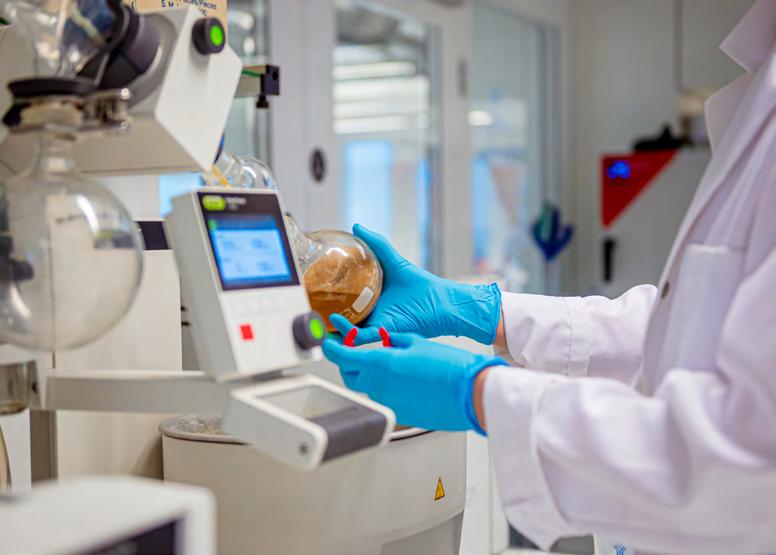
Fourteen million tonnes of microplastics are currently polluting the planet’s ocean floors. If we are to stand any chance of ending this environmental catastrophe, we need new and innovative technologies to come to the rescue. DePoly, based in Sion, may just have come up with one of them.
It is one of the worst environmental disasters we face today. The scientific community even estimates that by 2050 there could be more plastic than fish in our oceans. The problem is an urgent one, but an extremely promising new technology may well play a key role in managing plastic waste in the future. This technology developed by DePoly uses a chemical reaction to break down PET in a process that recovers the components, making them fully recyclable.
And that’s not all. This start-up offers an important economic advantage: its recycling process is more competitive than those used by its rivals, creating a saving of between 50 and 100 Swiss francs per recycled tonne. Another benefit of this technology is that the constituents it produces by recycling plastic waste are of the same quality as those manufactured by the oil industry.
A FUTURE WORLD LEADER IN CHEMICAL RECYCLING Currently in the scaling-up phase of this technology, DePoly has had an operational demonstration plant up and running since the end of 2020. And thanks to the interest generated by its technology, the company is already maintaining and developing partnerships with a number of Swiss and international industry players, including the central Valais waste treatment plant UTO and L’Oréal. «Our objective is to recycle on a vast scale in large recycling plants, becoming the world leader in chemical recycling», says company cofounder Samantha Anderson. «I think plastics are going to be around for a long time to come, chiefly because demand is continuing to grow, and so we need to find a more environmentally friendly way of living with them.»
With this process, DePoly has come up with a concrete circular-economy solution to deal with a thorny problem. The negotiations under way with some big names in the chemicals industry show that DePoly’s approach has hit the mark. They are a product of the start-up’s ability to forge solid links within the Swiss and European entrepreneurial and academic ecosystem, as evidenced by its collaborations with incubators and accelerators such as The Ark, Climate-KIC, Venture Kick and Venture Lab.
DEPOLY www.depoly.ch s.anderson@depoly.ch
Using construction waste to build better

Construction waste is a precious resource. Why not recycle it to make concrete? An area that Eberhard has made a speciality.
In Switzerland, less than 10% of new buildings are built using recycled materials. But the potential is far higher: every year, Switzerland’s demolition sites produce 7.5 million tonnes of construction waste. At the same time, some 26 million tonnes of sand and gravel are used in new constructions. As a pioneer in the field of urban mining, Eberhard is well aware of this crucial sustainability issue. In fact, the Kloten-based family business has been recycling building materials since 1983. With 40 years’ experience, this SME with a 600-strong workforce produces recycled concrete of the same quality, or better, than most commonly used new concretes.
«Old habits die hard, and we often hear people saying that recycled concrete can’t possibly be as good quality, which is absolutely not the case, especially given the knowledge and expertise we have today», bemoans Eberhard ’s communication director Astrid Gloor. WHEN DECONTAMINATION AND RECYCLING GO HAND IN HAND Eberhard steps in at the beginning of the process, when a structure is being demolished, and is involved right up to delivery of the recycled concrete to another construction site, bringing to bear its extensive stock of machinery and network of logistics centres where the materials are deposited, recycled and then re-dispatched. In addition, the company, which operates mainly in Switzerland, has worked at broadening its offering, also specialising in decontaminating polluted industrial sites and landfills. With the exception of certain highly polluted products that have to be stored in controlled landfills, it is able to treat the contaminated materials so that they can be re-used on building sites.
In 2020, Eberhard was awarded the Swiss ‘Umweltpreis der Wirtschaft’ environmental award for its knowhow in and commitment to innovation in sustainability. A distinction that backs up its expertise and reputation among building industry players which, if they are strictly meeting the regulations in force in some Swiss cantons, should be using at least 20% recycled concrete in every new structure they build.
EBERHARD www.eberhard.ch astrid.gloor@eeberhard.ch
Turning plastic bottles into houses
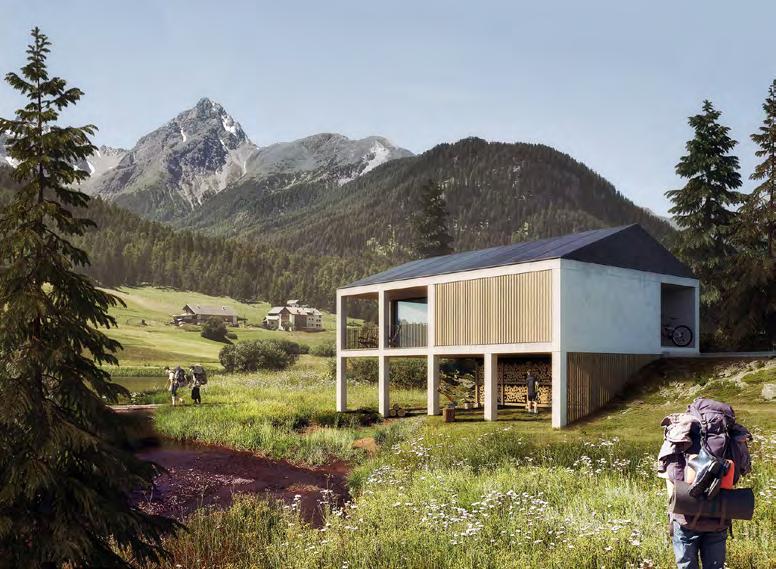
Using PET to build affordable, quality houses for the masses: this is the ambition of UHCS (Ustinov Hoffmann Construction System) in Sion, which is all set to unveil its first house there.
These plastic houses – the brainchild of Igor Ustinov and André Hoffmann – may well revolutionise the housing sector. So, how does this construction system work? It consists of extruded profiles made of recycled and recyclable PET that fit together like Lego to build a complete structure that meets the most stringent Swiss (SIA) and international (ISO) construction standards. It is based on a modular cubic system that can be adapted to the culture and architectural traditions of each country. The project also creates a complete circular economy concept, from collecting the waste to manufacturing the profiles and right up to constructing energy-positive passive buildings.
Using this technology, UHCS’s ambition is to take the dormant plastic waste economy into profit, contributing to housing development without impacting the environment. «By putting this waste to good use, we could provide housing for billions of people,» says Igor Ustinov. «We can do all that without cutting down trees or extracting sand from rivers or the coast, and we’ll save vast quantities of water that are essential to the cycle of life». The research institute Carbios estimates that the market lost by the failure to recycle the 360 million tonnes of plastic produced is 100 billion dollars a year. And when it comes to the quantity of used PET available in Kenya’s waste sites, UHCS has done the sums: they think there is enough to build 100,000 60m2 homes. The company has also filed a PET collection patent: «If it is to be used to benefit as many people as possible, this material should not be allowed to become a speculative commodity.»
A MINIMAL CARBON FOOTPRINT The manufacturing protocols have been perfected and are exportable, making it possible to distribute franchises to local partners all over the world. UHCS is targeting an average price well below that of a house built using conventional materials, but one that still allows for some innovative and surprising living comfort solutions. «And that’s besides the advantage of its minimal carbon footprint and the fact that it also offers a solution to the costly waste problem, since waste can be repurposed locally.»
A prototype is currently on the drawing board in Valais. By building the first house in Switzerland, UHCS is making a statement that this project is very much Made in Switzerland. Because this construction system was not conceived solely for developing countries. It is the first to offer unrivalled innovative, recyclable comfort, paving the way for a new approach to living in harmony with the environment. The UHCS system was awarded the ‘Efficient Solution’ label by the Solar Impulse Foundation in 2020.
UHCS www.ustinovhoffmannconstructionsystem.com Info@uhcs-constructions.com
Composite materials that repair themselves
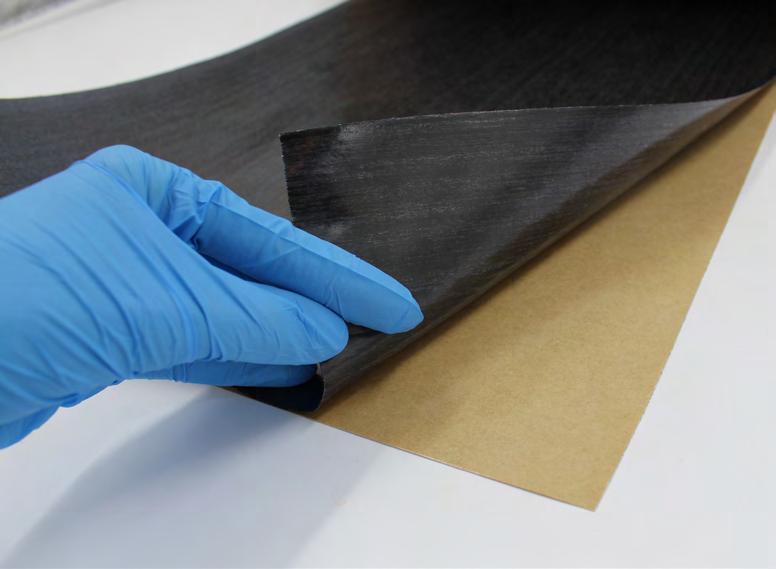
CompPair’s pre-impregnated textiles are based on innovative chemistry. As their name, HealTech, implies, they lead to reduced maintenance costs and an increase in the useful life of composite structures.
While composite materials have the advantage of resilience and lower weight, they are susceptible to damage – if the structure is affected by cracks or tears, repairs can often take a long time, which means that users tend to replace the element rather than having it repaired. Such a choice is all the more regrettable in a world where the recycling of composite materials is costly and far from ecologically friendly. Repairs can also affect the original performance of the material.
Amaël Cohades, co-founder of CompPair and holder of a doctorate in self-repairing composite materials, was inspired by nature to develop a technology that looks set to revolutionise the field of composites. «Living organisms have the capacity to regenerate themselves, and we’ve developed a technology in line with that principle.» The company produces rolls of textiles (fibreglass or carbon fibre) pre-impregnated with a ‘self-repair’ resin, aimed at producers of rigid composite parts.
REPAIRS THAT DON’T COMPROMISE THE STRUCTURE’S PROPERTIES CompPair’s naturally inspired technology makes it possible to repair a crack in situ, within a minute. ‘Healing the wound’ is simply a matter of heating the material to a temperature of between 100 and 150°C. This activates the repair, and the damaged element will self-repair while preserving its initial properties. There are many fields of application for this, including boating (repairing faults in the hull or the mast), energy (direct repair of impact damage to the blade of a wind turbine), storage (repairs to cracks in tanks and cisterns), transport (aerospace, road, rail), and sports (kayaks, bicycles, hockey).
The start-up is currently establishing its position on the market and seeking to raise capital. «Customers are already trialling our products on a small scale. The idea is to move forward with pilot implementation before starting series production during 2021.» At the same time, CompPair is continuing to develop new product families with a clear vision: that the circular economy should be applied to the composites industry. The business has been awarded the Solar Impulse Efficient Solution label.
COMPPAIR www.comppair.ch contact@comppair.ch
Excavation waste that’s worth its weight in gold
Using the mineral waste from excavation works to make concrete is the idea currently being perfected by Oxara. Founded by Gnanli Landrou and Thibault Demoulin after their doctorate at the Federal Institute of Technology, the spin-off is already attracting the interest of several industrial collaborators.
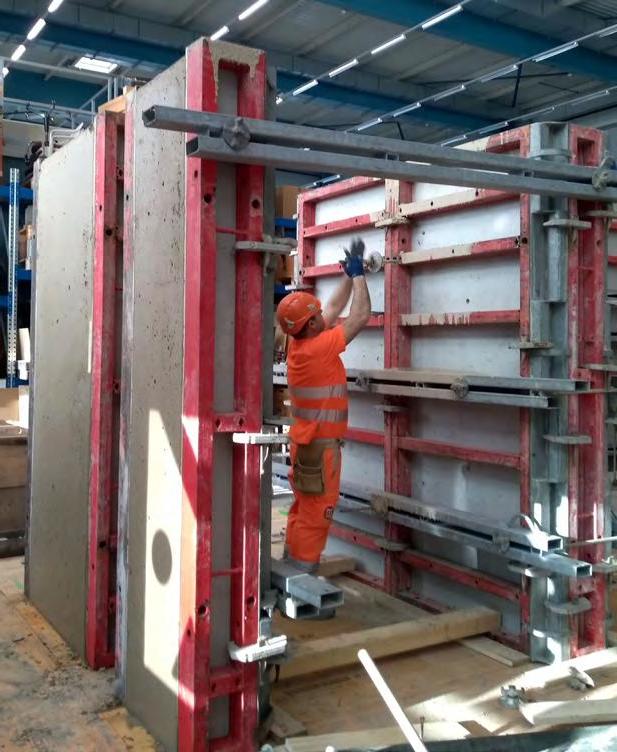
It is estimated that almost a third of all waste generated comes from construction and demolition works. Bulk waste that cannot be reused has a heavy toll on the ecological balance sheet, particularly since it is usually transported a long way from the place it originates. And what if it were possible to make concrete without the use of cement, by recovering this excavation waste? This is the idea that is currently being perfected by Oxara.
Cleancrete©. The name says it all with this new generation of concrete, produced on the basis of an innovative ecological additive developed by Oxara. Not only are there substantial environmental benefits – in particular because it avoids the use of cement, thus considerably reducing the quantity of CO2 emissions while reutilising local resources more or less in situ – but there is also a real economic advantage, since the product costs 10 to 20% less than conventional concrete. Last but not least, Cleancrete© facilitates humidity control as well as improving indoor air quality.
Oxara's innovation could be used for structures up to three storeys high or non-structural elements within buildings, a profile that corresponds precisely to the Swiss architectural and urban landscape configuration. REUSING 60 TO 70% OF LOCAL WASTE PRODUCTS Together with various local industrial enterprises, in particular in the German-speaking countries (Germany, Austria and Switzerland), Oxara is currently working towards validating the pilot version of its product. «Waste generated by construction and demolition works is not only ecologically detrimental; it is also problematic from an economic point of view, because, apart from the fact that it is not reused, it is expensive to transport it to tipping sites,» says Gnanli Landrou. «Our procedure could enable between 60 and 70% of this waste to be reused, with the emphasis on short, local loops.»
Another argument in favour of this kind of recovery is that the restrictions on international exchanges due to the pandemic could make it increasingly difficult to import construction materials. With borders less open than before, making use of local resources could well become an essential aspect of the construction industry too.
OXARA www.oxara.ch landrou@oxara.ch
Back down to earth
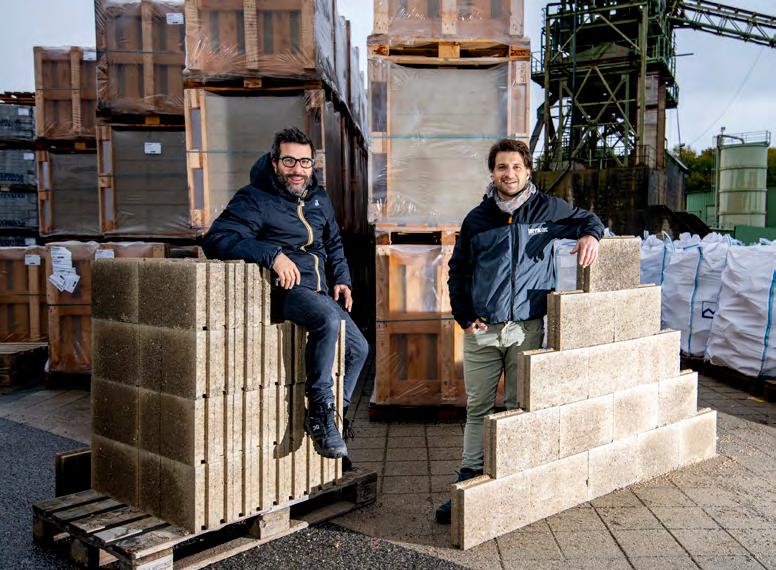
Terrabloc is reintroducing a material that had almost been forgotten: raw earth. The company has shown that the use of compressed-earth bricks for construction is anything but ancient history. Indeed, the possible applications for this abundant material are numerous.
Terrabloc’s mission is to widen the scope of earth in the construction industry. «It has been completely forgotten in the western world, yet 40% of humanity still live within earth walls,» says Laurent de Wurstemberger, one of the company’s co-founders. He adds that on Genevan soil alone, some 3 million cubic metres per annum are extracted during building site excavations – a real case of lost brick-making opportunities! Apart from this potential monetisation, earth also offers a number of other qualities: it has a high thermal inertia (the capacity to store and release heat), it regulates humidity and it provides effective sound insulation. Its potential applications are many and varied, both for building shells (load-bearing walls) and interior work (partitions, dividing walls).
ACADEMIC PARTNERSHIPS AND PUBLIC COMMISSIONS Prior to founding Terrabloc, Laurent de Wurstemberger (architect) and Rodrigo Fernandez (materials engineer graduate of the Lausanne Federal Institute of Technology (EPFL)) already had a suitably ‘downto-earth’ approach. Laurent de Wurstemberger was managing an architects’ practice and was about to finish a construction project using pisé (raw earth), while Rodrigo Fernandez had explored earth bricks for his Master’s degree and calcined clays for his PhD thesis. «We were well aware of the complexity of introducing a new product, as well as the standards to be complied with.» Winning a sustainable development grant from the canton of Geneva in 2011 enabled them to buy a semi-automatic hydraulic press and undertake a series of tests. Their first physical project was in 2015 with the construction of a facing wall for an exhibition building for the Geneva utility company Services Industriels de Genève.
After five years of small-scale production, Terrabloc now aims to make raw earth more readily available to all. «We don’t want it to be an elitist product, and an industrial approach means that we can reduce the production costs.» The blocks are now manufactured using machinery supplied by Cornaz, in the Swiss municipality of Allaman, a company that specialises in the production of concrete paving stones. Terrabloc has also established a number of academic partnerships (EPFL, the Geneva School of Engineering, Architecture and Landscape (HEPIA) and the School of Engineering and Architecture in Fribourg (HEIA-FR)) and has obtained a number of public service commissions. The most notable to date is the supply of 800 m2, or 6400 units, of large-format ‘Terrapad’ earth blocks measuring 80 x 30 x 15cm, for the planned Environment Centre (Maison de l’Environnement) in Lausanne, a building that will house the 160 employees of the general environment directorate (DGE).
TERRABLOC www.terrabloc.ch info@terrabloc.ch
Modern-day alchemists

INNOmaterials’ quest is not to find the philosophers’ stone but to create new materials based on elastomers. Rubber holds no secrets for this Jurabased company, which develops and implements formulas that are as unexpected as they are varied.
Filomeno Corvasce, CEO of INNOmaterials, compares his team to a band of inspired chefs. «Our customers come to us when they want to develop a new elastomer-based material with a composition that must meet certain specifications. We then cook up a simple colour or a particular material for them.» For Corvasce, who holds a PhD in Materials Physics, there is no limit to possible formulations, thanks to the developments in nanotechnology that have appeared over the last twenty years. Metallised, pearly, glittery, transparent, phosphorescent, fluorescent, perfumed, hydrophobic, antistatic or antibacterial: there is a whole universe of possibilities. While INNOmaterials mainly works for clients in the watchmaking industry, it is also present in fields as diverse as agriculture, automotive, medical and aerospace with elaborate elastomer formulations (cut-resistant, anti-vibration, anti-magnetic, etc.).
Since 2019, INNOmaterials has been a partner of the Origin Group, a major player in the elastomer sector. The group has 14 companies in Europe, including Valiance, a firm that specialises in rubber moulding and overmoulding by vulcanisation. And when INNOmaterials takes on R&D projects to develop ‘recipes’, it can count on a worldwide network to test them. NEW MATERIALS DERIVED FROM BIOLOGICAL MATERIALS Designing ecomaterials, such as composite thermoplastics based on sugar cane fibres or elastomers that are biobased (i.e. derived from biological materials), is another field where INNOmaterials is active. «Plastic packaging can take a whole new route if polymers are used that are not derived from petrochemicals. We have developed elastomer formulas that can contain more than 75% biobased materials.»
Here, too, there are myriad applications: while the focus continues to be on watchmaking, ecological thermoplastics can also be used in the composition of patio flooring or wall claddings, bottles, and packaging for cosmetic products. Leather recycling is also being explored: the alchemists at INNOmaterials can turn scraps into large pieces of leather.
INNOMATERIALS www.innomaterials.net fcorvasce@innomaterials.ch
Tyres get a second lease on life
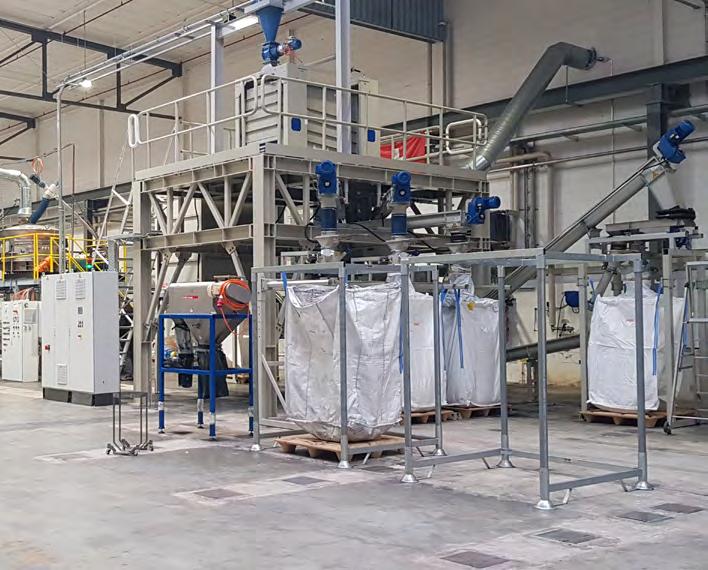
Tyre Recycling Solutions (TRS) has developed a novel process for recycling tyres, reducing them to a rubber powder that can be used for a variety of industrial purposes.
«Our aim is to reintegrate old tyres into a circular, unsubsidised and economically viable economy,» explains Staffan Ahlgren, CEO and co-founder of TRS. And the future looks bright for the Vaud-based company. After seven years in business and having raised more than 25 million francs, in November 2020 TRS began a collaboration with Trinseo*, one of the world's leading suppliers of materials solutions and producers of plastics, latex binders and synthetic rubber.
Wanting to transform the tyre recycling market, TRS has developed several innovations, including a machine that cuts tyres in three in just thirty seconds, halving shipping costs and tripling storage volumes. The company has also developed a high-pressure water jet (2500 bars) that transforms the treads on used tyres into a fine powder.
TESTING ON SWISS ROADS The tyres’ metal and synthetic fibre are separated from the rubber and resold on the market. The high-pressure water jet endows the powdered rubber, called TyreXol™, with new mechanical properties that improve its ability to mix with other materials. As a result, it can be used in new tyres, moulded car parts, roof insulation, industrial cables, gaskets, shoe soles and asphalt. It can also be mixed with plastic packaging waste to produce floor coverings, truck loading ramps and other industrial applications.
More than 300 customers are currently testing the powder developed by the company, starting with the cantonal services responsible for road infrastructure in western Switzerland, which, in early July 2020, chose TyreXol™ to repair a section of cantonal road in the Jura. Testing is also under way in the cantons of Vaud and Valais. In addition, TRS is continuing its tests in its Préverenges research lab to find other opportunities with new applications. A turnkey demonstration plant has also been in operation in Yvonand since the start of 2020.
TYRE RECYCLING SOLUTIONS www.trs-ch.com sah@trs-ch.com
Rejuvenation for parquet floors

Bauwerk wants people to recycle their wooden parquet to limit the consumption of forest resources. Between Switzerland, Europe and Asia, the company based in the canton of St. Gallen promotes a virtuous economic cycle that also benefits its customers.
The average life cycle of a parquet floor is fifteen to twenty years. However, despite obvious signs of wear and tear after years of use, this robust floor covering can be reprocessed to last for three or even four more cycles. Recycling it in this way not only reduces the use of forest resources but also offers economic benefits for consumers. It is precisely in this niche in the circular economy that Bauwerk has specialised. The company has adopted a sustainable and innovative approach based on the use of a special glue that makes it easier to dismantle parquet floors once they have reached the end of their first life cycle. Once back in the manufacturing plant, the product is sandblasted to remove those signs of wear and tear before being finished in a different colour or pattern and finally reused.
The process offers customers some interesting benefits. In addition to the satisfaction of the product’s environmental added value, they can also enjoy discounts on the purchase of another Bauwerk floor if they decide to give their first product back to the company. Customers also have the option of taking back their original parquet once it has been reprocessed by Bauwerk. AN INTERNATIONAL VIRTUOUS CIRCLE Bauwerk currently exports 75% of its production, mainly to the rest of Europe. In addition to its headquarters near Lake Constance, the company has production plants in Lithuania and Croatia, and branches all over the world.
One of Bauwerk's main challenges is to continue its efforts to raise consumer awareness. «Because today, while environmental awareness is clearly flourishing in many fields, such as in the automotive industry for example, efforts still need to be made in our sector», says Klaus Brammertz, the company's CEO. The general public still opts all too often for materials derived from the oil industry, such as vinyl or PVC – products that have a higher carbon footprint and are not reusable.
BAUWERK www.bauwerk-parkett.com klaus.brammertz@bauwerk-group.com
Using electrochemistry to treat waste water

A Swiss electrochemical process developed originally to dissolve indigo dye is now being used in waste water treatment applications.
When David Crettenand, director of RedElec Technologie, began researching how to dye jeans made of denim (a cotton fabric with a very dense weave) more than 15 years ago, he was the only student at the Swiss Federal Institute of Technology in Zurich to tackle a problem that had been on the cards for a very long time. «To apply indigo dye – which is insoluble in water – to denim, you have to add a chemical reagent. Scientists have been looking for an alternative electrochemical solution for a century.» With the new electrochemical reactor patented by RedElec, this process is now sustainable and has been introduced in several production plants in China, Pakistan, Bangladesh and India. And this technology not only works in the denim industry, but also in energy storage and waste water treatment. The Valais-based company is today focusing on the latter.
FROM BLUE JEANS TO WWTPS RedElec now offers an effective way of treating aqueous industrial effluents to make them compatible with subsequent treatment in waste water treatment plants (WWTPs). The process also works well in recovering metals (copper, nickel, gold and silver) and removing micropollutants. «We come into play on industrial sites, where the effluents are most concentrated, using bacteria which ‘eat’ the micropollutants, giving sewage works an easy job of cleaning up the rest.»
Businesses working in the chemicals, pharmaceuticals, agrochemicals and biotechnology industries have also tasked RedElec with developing an alternative electrochemical method of redox transformation. And the company thought carefully before focusing its R&D on the Valais canton. «Going by the experience we acquired when developing the process for the denim industry, we’re better off building up our skills base locally before branching out internationally.» And for good reason: Valais boasts the perfect industrial and research environment for cutting-edge innovative businesses like RedElec.
REDELEC TECHNOLOGIE www.redelec.ch davidcrettenand@redelec.ch
A paradigm shift in the motor industry
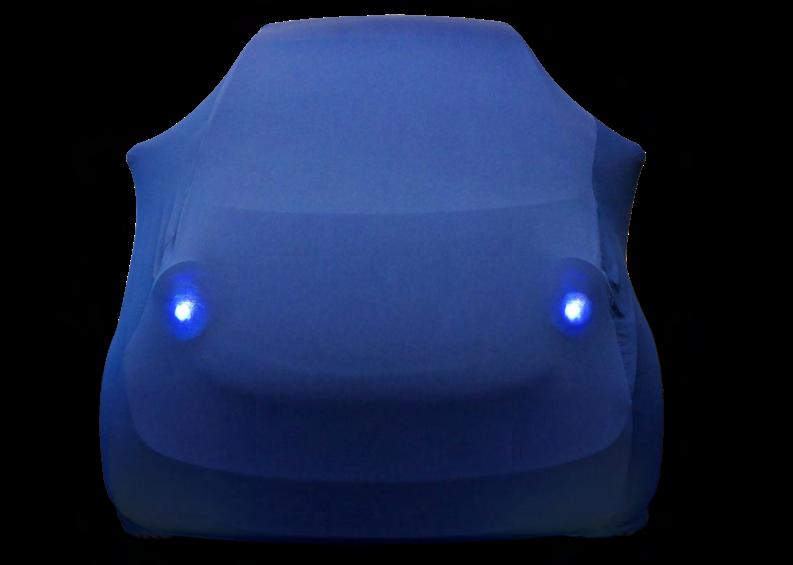
An electric car with the lowest ecological footprint ever achieved: that is Softcar’s declared objective. To make this happen, Softcar is relying chiefly on a manufacturing concept based on the decentralised cloud factory model. The Softcar is due to be launched in Switzerland in summer 2021.
The idea of a ‘clean’ electric vehicle took shape in Softcar director Jean-Luc Thuliez’s mind as a result of his successive industry experiences. He was previously involved in developing the Swatchmobile, the brainchild of Nicolas Hayek, and the Total Car, the first vehicle to be made of a biopolymer (a material made from biomass). «But I’ve never felt so strongly that now is the right time», says an upbeat Jean-Luc Thuliez.
Whereas a conventional car running on petrol or diesel is made up of nearly 40,000 components, the Softcar has only 1,800 parts and is much lighter because it is made of biopolymers instead of steel, a dense metal that adds considerable weight to conventional cars. All of the Softcar’s mechanical parts will be reusable, unlike in conventional vehicles, where worn parts have to be disposed of. And it will be possible to remould the Softcar’s bodywork up to 10 times. Because the Fribourg-based company has set the bar high: it wants to take the motor car into the circular economy. What’s more, every stage of each product’s life cycle has been designed to reduce its CO2 footprint. «We take into account the impact of production on water quality, air quality and soil quality, along with raw material and energy consumption», says Jean-Luc Thuliez. DECENTRALISED PRODUCTION UNITS On the production lines you won’t find robots, cataphoretic immersion priming or electroplating, and there’s no welding either, because no steel is involved. The four modules that make up the Softcar are set to be assembled in plants close to megacities. A business model that plans to do away with the long production lines on which vehicles are conventionally made before being shipped to the four corners of the planet. This is the ‘cloud factory’ principle, a one-of-a-kind, decentralised production model that makes use of small, modular assembly centres that can be easily replicated. This reduces both the financial investment involved and the amount of pollution generated by production.
Lastly, users will be able to choose which shape they want their car to have, but for now Softcar is keeping what that means in practice under the hood... until the Softcar launch, planned for 21 June 2021!
SOFTCAR www.softcar.ch info@softcar.ch
Using biomass to bring on circularity
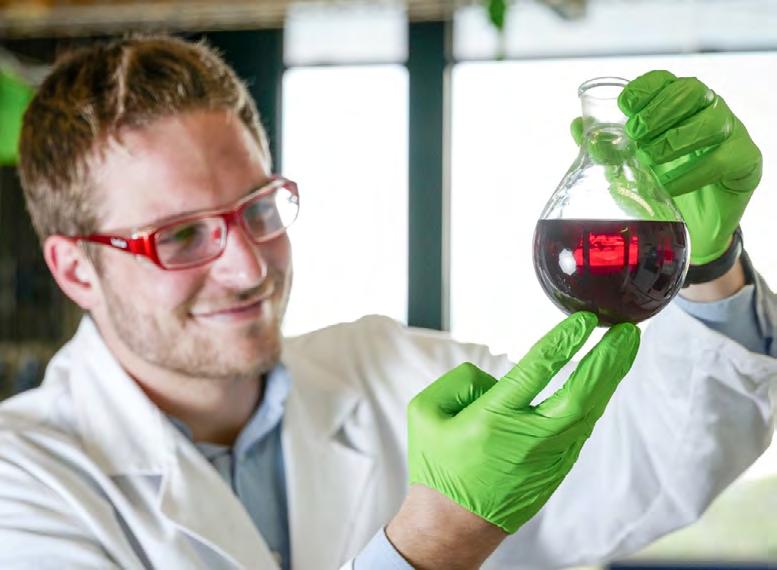
In the race to decarbonise to create a more sustainable society, we urgently need to find alternatives to oil. Besides their use in energy generation and mobility, petrochemical processes are involved in the production of plastics, fragrances and flavourings. But now, a startup has come up with a way of replacing the black gold with biomass.
Using trees and agricultural waste to produce fuels, plastics, perfumes and other molecules for the cosmetics and food industries: that’s where the Marly-based start-up Bloom Biorenewables comes in. These products and molecules are currently produced by the petrochemicals industry, contributing to the increase in CO2 emissions. Turning to biomass means using much shorter carbon cycles of 20 to 50 years, roughly the time it takes for a tree to grow. This is a way of simply ‘borrowing’ the carbon, before returning it to nature, over a human timescale. «Our idea is to offer an alternative that goes some way to tackling the urgent problem of global warming, a consequence of our use of hydrocarbons on a massive scale. We offer a unique solution that makes use of plants and agriculture», says CEO Remy Buser.
AN IMPACT ON THE FOOD PRODUCTION, CHEMICALS AND TRANSPORT INDUSTRIES Currently in its pilot phase, within five years, the process that Bloom has developed should be able to produce these molecules in industrial quantities, replacing oil with biomass. This innovation has piqued the interest of industry giants keen to put into practice sustainable strategies in response to the climate emergency. Initially, the technology will be used in the production of plastics, fragrances and flavourings, but the shipping industry is also in Bloom’s sights.
The waste generated by Bloom’s biomass process can be re-used to make marine fuel oil. This promising innovative approach is being masterminded by IDEALFUEL, an EU-funded project involving a dozen different partners, including the Winterthur-based company WinGD (known as the manufacturer of the Sulzer diesel engine). «This area of our business involves rethinking from the ground up the design of a sustainable fuel to power the engines of merchant vessels», adds Remy Buser. An innovative approach for a sector that is being forced to reinvent itself to meet the new norms. And one that is urgently needed: the heavy fuel oil used by most cargo ships currently generates more pollution than the aviation industry.
BLOOM BIORENEWABLES www.bloombiorenewables.com remy@bloombiorenewables.com
This is how you clean soil sustainably!
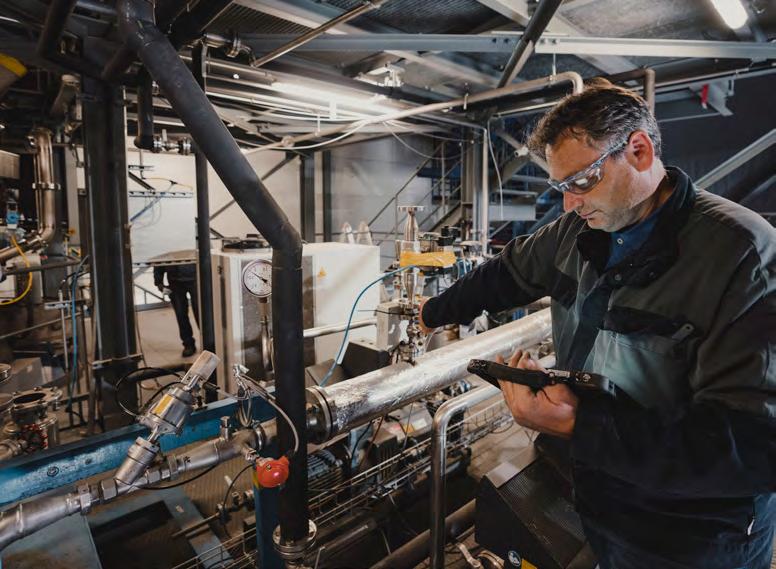
The Valais-based company BOWA Recycling AG separates pollutants from contaminated soil. Managing Director Remo Schnyder explains more.
BOWA Recycling AG decontaminates, treats, and either reuses or disposes of 40,000 tons of contaminated soil a year. Since 2013, the company has run a soil treatment facility in Susten (Valais), where contaminants are separated by a variety of processes. One of the reasons for setting up the company was the mercury contamination in Valais soil, particularly in the Visp and Raron regions. «Cleaning up the land here called for more powerful technologies than a conventional soil washing plant can offer», says Schnyder. This is why the company has invested continuously in the facility. Today, BOWA’s operation is one of the most modern in Europe. «We are in a very strong position compared to other market participants».
More recently, a second plant was opened in Steg. This means that thermal treatment can now be carried out alongside wet processing. In thermal treatment, the portions containing heavy metals such as mercury can be remediated too. «Previously, this material had to be transported abroad, where systems are generally not state of the art». It also means long journeys can be avoided. «It didn't make sense to transport thousands of tonnes of material by truck across half of Europe just to clean it». With its own thermal treatment plant, BOWA is attracting customers from beyond the cantonal borders. NO FOSSIL FUELS USED The thermal cleaning carried out in Steg has other advantages, too. «Whereas plants abroad use fossil fuels, here we do everything with electricity. And using indirect electrical heating means we can achieve higher temperatures. We also use a vacuum process». The plant can currently treat contaminants with an evaporation temperature of between 550 and 600 degrees. BOWA Recycling AG is planning to invest even more in thermal treatment and to expand its range of services. However, Schnyder sees potential for improvement in the demand for remediated soil in Valais. He points out that it is relatively low in this region, while some cantons have quotas that already need to be met.
Like BOWA Recycling AG, the industry is increasingly investing in the circular economy. However, a legal framework encouraging the integration of raw material recycling into projects is not easily put in place in Switzerland.
BOWA RECYCLING www.bowa-recycling.ch info@bowa-recycling.ch
Fireforce invents smokeless fire

The combustion process developed by Fireforce Technology enables biomass to be converted into thermal energy in a very clean, efficient way – an innovation that has the potential to revolutionise heat production.
The countryside of Vaud is home to a new kind of burner, the result of André Van der Veken’s research into biochar. André’s work began with the conviction that it makes far more sense to avoid polluting emissions altogether, rather than capturing them after burning. The results exceeded his expectations: analyses carried out by an independent laboratory show that he has successfully developed an ultra-clean process for burning wood pellets and chips, thus opening the way to cleaner, more efficient, more compact and more economical heating boilers and incinerators.
PRACTICALLY ZERO POLLUTION WITH AN INCREASED OUTPUT André Van der Veken’s objective is not only to equip wood burners with the Fireforce technology in order to limit their polluting emissions, but also to replace traditional fossil fuel systems with this type of installation. «The target is industrial installations or district heating systems of 500 kW and more», he says.
Thanks to its extremely low gas and particulate emissions, the Fireforce process does not need any kind of electrostatic precipitator for the exhaust fumes; without this additional equipment, boilers and incinerators take up less space. Another benefit is the increased output of between 8 and 30%. «Our prototype can take any kind of biomass with a moisture content up to 65%, which allows for the use of lower-quality, more competitively priced wood», André Van der Veken adds. The extended power regulation range means that the heat production can be closely adapted to users’ requirements; this wide range also means that maintenance interventions are kept to a minimum provided usage is within the reference values.
THE FIRST 100% RENEWABLE OLYMPIC FLAME IN THE HISTORY OF THE GAMES Regularly consulted for its expertise in the field of combustion, one of Fireforce’s claims to fame is its development of the burner for the Olympic flame for the most recent Youth Olympic Games, held in Lausanne. Fuelled by wood pellets sourced locally, it was able to produce a flame in 24-hour cycles without the use of electricity – an excellent example of energy efficiency with clear environmental benefits. Another of Fireforce’s notable contributions has been to the improvement of the technology used by Edelsun outdoor heaters.
FIREFORCE TECHNOLOGY www.fireforce-technology.ch info@fireforce-technology.ch
Working towards zero-carbon concrete
Reducing the construction industry’s worldwide carbon impact by one billion tonnes a year: this is the vision of the Bern start-up Neustark, which is developing high-tech solutions for climate-neutral 100% recycled concrete.
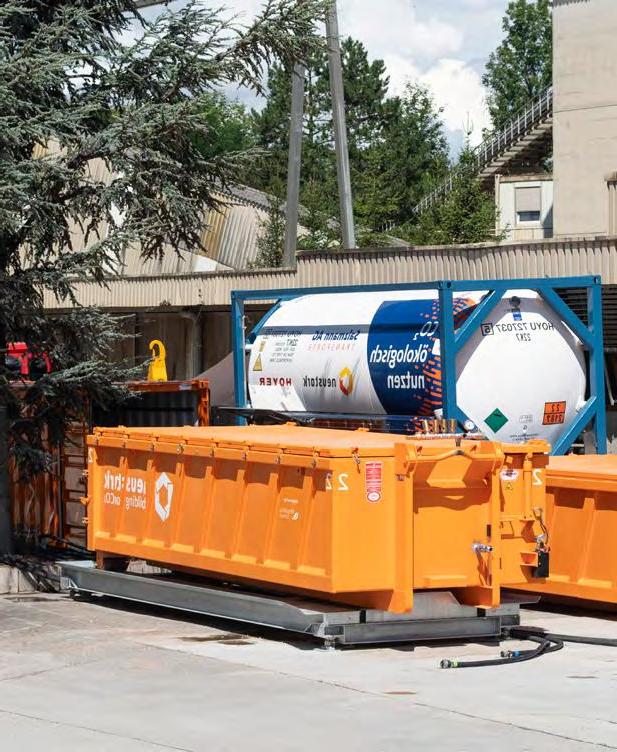
Worldwide CO2 emissions from concrete production are twice as high as those from the entire planet’s air travel industry, accounting for 7% of global emissions. Concrete is also the planet’s biggest source of waste. Because it processes CO2 and also reduces the amount of cement used to make concrete, the technology developed by Neustark is set to reduce the carbon footprint of concrete production. This spin-off of the Swiss Federal Institute of Technology in Zurich, founded in 2019, is headed by Valentin Gutknecht and Johannes Tiefenthaler. Gutknecht acquired his industry experience at Climeworks, the company that pioneered direct air carbon capture, while Tiefenthaler comes from a research background, investigating how CO2 reacts with different mineral substances and how these substances can bond to make limestone.
To make concrete, you need to mix cement, sand, gravel and water. The technology developed by Neustark binds the CO2 in the pores and on the surface of a granulate made from demolition concrete to make limestone. An innovative solution which means that less cement can be used without impairing the properties of the concrete. This enriched granulate can also be mixed with fresh concrete in place of the sand and gravel conventionally used. OF CONSIDERABLE INTEREST TO THE CONCRETE INDUSTRY «Producing the cement required to make one cubic metre of concrete emits more than 150 grams of CO2», says Gutknecht. «Our solution currently enables us to reduce these emissions by 10 to 15%, and we’re aiming to develop a totally carbon-neutral concrete». The technology is operational for commercial applications and is already being used in two Swiss concrete plants. Neustark is working with the Kästli group near Bern, where the CO2 used is obtained from the biogas separation installation of a neighbouring waste water treatment plant. The solution is currently being delivered using mobile units, but an integrated facility is due to be installed there in the near future. The technology is of considerable interest to the concrete industry. «We’re talking to 80% of Switzerland’s concrete producers, including Holcim, with whom we’re carrying out materials tests». What does the future hold? Neustark wants to be 'operating stably' in Switzerland and neighbouring countries before it takes on the rest of the world. It has five serious international competitors. «But as far as we know, we are the only company to offer a simple solution that can be immediately incorporated into any concrete production plant».
NEUSTARK www.neustark.com hello@neustark.com
References
1 Kenneth E. Boulding, Future of Personal Responsibility, 1972, p. 350-351
2 https://www.overshootday.org/newsroom/country-overshoot-days/
3 It is important not to regard recycling as THE solution, but as complementary to other strategies. From an environmental point of view, recycling consumes energy and can have considerable impact.
4 https://regiosuisse.ch/en
5 https://www.admin.ch/opc/en/classified-compilation/19830267/index.html
6 https://www.admin.ch/opc/fr/federal-gazette/2019/4329.pdf
7 https://www.admin.ch/gov/fr/accueil/documentation/communiques.msg-id-78079.html
8 https://www.bfs.admin.ch/bfs/en/home/statistics/catalogues-databases.assetdetail.13487975.html
9 https://www.petrecycling.ch/fr/savoir/chiffres-et-faits/faits
10 https://www.bafu.admin.ch/dam/bafu/fr/dokumente/abfall/statistik/abfallmengen-recycling-2018.pdf.download.pdf/Abfallmen gen%20und%20Recycling%202018%20im%20%C3%9Cberblick%20f.pdf
11 https://www.bafu.admin.ch/bafu/en/home/topics/waste/guide-to-waste-a-z/biodegradable-waste/types-of-waste/lebensmittelab faelle.html
12 https://www.avenir-suisse.ch/fr/recyclage-ou-elimination/
13 https://www.heidi.news/economie/la-moitie-de-l-empreinte-ecologique-suisse-provient-des-importations
14 https://www.bfs.admin.ch/bfs/en/home/statistics/catalogues-databases/tables.assetdetail.14347536.html
15 https://www.bfs.admin.ch/bfs/fr/home/statistiques/agriculture-sylviculture/alimentation/industrie-commerce-gastronomie.html
16 https://www.wwf.ch/fr/nos-objectifs/classement-wwf-de-la-filiere-agroalimentaire#:~:text=En%20Suisse%2C%20l'alimenta tion%20compte,empreinte%20%C3%A9cologique%20de%20la%20population.&text=En%20effet%2C%20en%20Suisse%2C%20 l,l'empreinte%20%C3%A9cologique%20du%20pays
17 https://www.agrarbericht.ch/fr/marche/developpement-du-marche/taux-dauto-approvisionnement
18 https://www.bafu.admin.ch/bafu/en/home/topics/waste/guide-to-waste-a-z/biodegradable-waste/types-of-waste/lebensmittelab faelle.html
19 https://www.wwf.ch/fr/nos-objectifs/gaspillage-alimentaire
20 Agroforestry is based on the principle of associating fruit or forest trees with food crops. The presence of trees and plant matter encourages the proliferation of microorganisms which enrich the soil without adding chemical fertiliser. The trees also lessen the effects of the weather, regulate the water supply, provide shade and cover the soil with branches and leaves.
21 https://www.letemps.ch/economie/pari-suisse-guerre-contre-plastique
22 https://punkt4.info/die-ausgaben/details/news/nationalraete-wollen-wiederverwertung-von-kunststoffen-foerdern/punkt4-edi tion-name/circular-economy-news/punkt4-edition-section/17755/punkt4-date/15-09-2020/punkt4-news-context/newsletter. html?tx_news_pi1%5Baction%5D=detail&tx_news_pi1%5Bcontroller%5D=News&cHash=f00afc797befbc4c168342aba536789f
23 https://blogs.letemps.ch/delphine-klopfenstein-broggini/2019/01/14/chaque-seconde-la-suisse-betonne-5-metres-carres/
24 https://www.bafu.admin.ch/dam/bafu/en/dokumente/allgemein/uz-umwelt-zustand/umwelt-schweiz-2018.pdf.download.pdf/ Umweltbericht2018_E.pdf
25 FOEN: https://www.bafu.admin.ch/bafu/en/home/topics/waste/in-brief.html
26 https://www.bafu.admin.ch/dam/bafu/fr/dokumente/wirtschaft-konsum/externe-studien-berichte/Atlas%20environnemental_ La%20Suisse%20et%20ses%20cha%C3%AEnes%20d%E2%80%99approvisionnement_200828.pdf.download.pdf/Atlas%20envi ronnemental_La%20Suisse%20et%20ses%20cha%C3%AEnes%20d%E2%80%99approvisionnement_200828.pdf
27 https://www.bfe.admin.ch/bfe/en/home/swiss-federal-office-of-energy/the-swissenergy-programme/strategy.html
28 https://reriwi.ch/wp-content/uploads/2020/07/Construire-Re%CC%81emploi-2020-3.pdf
29 For gravel in particular
30 Magazine of the Swiss gravel and concrete industry association (Association suisse de l’industrie des graviers et du béton, ASGB): https://www.fskb.ch/wp-content/uploads/2019/10/FSKB_INFO_2019_FR.pdf
31 https://www.zh.ch/de/planen-bauen/bauvorschriften/bauen-an-besonderer-lage/bauen-belastete-standorte.html
32 https://www.bafu.admin.ch/bafu/fr/home/themes/sante-et-bienetre/mitteilungen.msg-id-79218.html
33 https://www.empa.ch/fr/web/s604/umar-opening
34 https://www.bamb2020.eu/topics/reversible-building-design/
35 https://www.greentransformablebuilding.com/
36 https://www.bamb2020.eu/topics/pilot-cases-in-bamb/bric/
37 bouygues-construction.com/blog/en/construire-durablement/reversibilite-batiments/
38 bafu.admin.ch/bafu/fr/home/themes/forets/info-specialistes/etat-et-fonctions-des-forets/production-de-bois/utilisation-du-bois.html
39 https://www.rts.ch/info/economie/10186584-les-batiments-en-bois-prennent-de-la-hauteur-et-de-l-importance-en-suisse.html
40 https://www.24heures.ch/vaud-regions/bois-offre-chantiers-ideaux-savent-anticiper/story/17276848
41 https://www.espazium.ch/fr/actualites/le-bois-en-circuit-court
42 http://www1.onf.fr/mecenat/sommaire/niveauvide/partenaires/20091110-154834-555353/2/++files++/4
43 https://www.batimag.ch/construirebois
44 https://www.batimag.ch/construirebois
45 https://www.dezeen.com/2019/03/19/mjostarne-worlds-tallest-timber-tower-voll-arkitekter-norway/#:~:text=Mj%C3%B8s t%C3%A5rnet%20by%20Voll%20Arkitekter%20in,Tall%20Buildings%20and%20Urban%20Habitat.
46 This figure is an estimate of the volume that includes consumer electronics and only some electronic office and ICT equipment.
47 https://www.swico.ch/fr/connaissances/etudes-de-marche/statistiques-et-donnees/#printingimagingfinishing
48 https://www.swico.ch/fr/news/detail/performances-inegalees-taux-de-recyclage-de-95
49 https://circulareconomy.europa.eu/platform/sites/default/files/circular-economy-in-the-furniture-industry.pdf
50 https://de.statista.com/themen/4048/textil-und-bekleidungseinzelhandel-in-der-schweiz/
51 The Circular Economy Handbook. Realizing the Circular Advantage. Peter Lacy, 2020.
52 https://www.greenpeace.org/international/story/7575/copenhagen-fashion-summit-how-not-to-make-the-fashion-industry-moresustainable/
53 Cosmetics can be subdivided into beauty care products and decorative cosmetics; beauty care products used for personal hygiene come under healthcare products, while decorative cosmetics follow fashion trends.
54 https://de.statista.com/statistik/daten/studie/283709/umfrage/umsatz-mit-kosmetik-und-koerperpflegeprodukten-in-der-schweiz/
55 https://de.statista.com/statistik/daten/studie/283705/umfrage/umsatz-mit-wasch-putz-und-reinigungsmitteln-in-der-schweiz/
56 https://www.skw-cds.ch/wasch-reinigungsmittel/zahlen-fakten/
57 https://www.srf.ch/news/schweiz/umweltbelastung-mikroplastik-in-kosmetika-verbieten-oder-freiwilliger-verzicht
58 https://www.bafu.admin.ch/dam/bafu/de/dokumente/abfall/externe-studien-berichte/plastik-in-der-schweizer-umwelt.pdf. dowload.pdf/plastik-in-der-schweizer-umwelt.pdf
59 https://www.pianoo.nl/sites/default/files/documents/documents/reportcircularcategoryenoktober2016.pdf
60 http://www.rebus.eu.com/wp-content/uploads/2019/03/Office-furniture-according-to-circular-principles.pdf
61 https://www.ioeb.at/fileadmin/ioeb/Dokumente/ECOVATION/REUSE_gesammelt.pdf
62 A disruptive technology is a technological innovation related to a product or service that ends up replacing a dominant technology on a market.
63 https://www.circularise.com
64 https://www.gdiapers.com/pages/gcycle
65 https://www.zesar.ch/de/bildung/produkte/Miet
66 https://www.hilti.ch/content/hilti/E3/CH/fr/services/services-outils/fleet-management.html
67 https://www.nzz.ch/wirtschaft/hilti-per-zufall-pionier-der-kreislaufwirtschaft-ld.1576702?reduced=true
68 https://www.bfs.admin.ch/bfs/fr/home/statistiques/industrie-services/entreprises-emplois/statistique-emploi.assetde tail.14027950.html
69 https://panorama.swissmem.ch/fr/chiffres-actuelles/lindustrie-mem-dans-le-contexte-national.html
70 https://www.bafu.admin.ch/dam/bafu/fr/dokumente/wirtschaft-konsum/externe-studien-berichte/Atlas%20environnemental_ La%20Suisse%20et%20ses%20cha%C3%AEnes%20d%E2%80%99approvisionnement_200828.pdf.download.pdf/Atlas%20envi ronnemental_La%20Suisse%20et%20ses%20cha%C3%AEnes%20d%E2%80%99approvisionnement_200828.pdf, p. 33
71 https://www.buhlergroup.com/content/buhlergroup/global/en/about-us.html
72 https://www.gruenewirtschaft.admin.ch/grwi/en/home/green-economy-in-action/Resource-conservation-a-matter-of-quality.html
73 https://www.fundswatch.fr/bnpam/lavenir-sera-circulaire-pour-la-mode-et-le-luxe/
74 https://www.wwf.ch/sites/default/files/doc-2018-12/20181207_WWF%20Watch%20and%20Jewellery%20Report%202018_ final%20version.pdf
75 https://www.wwf.ch/sites/default/files/doc-2018-12/20181207_WWF%20Watch%20and%20Jewellery%20Report%202018_ final%20version.pdf
76 https://www.usinenouvelle.com/article/dans-l-emballage-le-luxe-se-refait-une-vertu.N952516
77 BCG-Altagamme, True-Luxury Global Consumer Insight 2019 study, 6th Edition
78 https://www.lvmh.com/news-documents/press-releases/lvmh-launches-first-standard-responsible-crocodilian-leather-sourcingthree-pilot-farms/
79 https://www.baume-et-mercier.com/en/watches/baume-joins-baume-et-mercier.html
80 https://publish.circle-economy.com/financing-circular-business
81 https://www.decaliagroup.com/wp/wp-content/uploads/2020/09/DecaliaEN.pdf
82 https://www.financecorner.ch/decalia-lance-le-premier-fonds-actions-dedie-a-leconomie-circulaire/
83 https://www.ellenmacarthurfoundation.org/assets/downloads/Financing-the-circular-economy.pdf
84 https://www.bas.ch/fr/a-propos-de-la-bas/le-modele-bas/nos-principes/modeles-daffaires-durables/
85 https://www.tourism-review.com/tourism-industry-is-the-pillar-of-economy-news11210#:~:text=According%20to%20the%20 latest%20data,the%20largest%20economic%20sectors%20worldwide
86 https://www.swissinfo.ch/eng/covid-19-impact_without-foreign-visitors--switzerland-s-summer-tourism-sea son-looks-gloomy/45829078
87 https://www.vie-publique.fr/eclairage/24088-le-surtourisme-quel-impact-sur-les-villes-et-sur-lenvironnement#:~:text=Le%20tou risme%20est%20%C3%A0%20l,%C3%A9missions%20de%20GES%20de%20131%25
88 https://www.unwto.org/sustainable-development
89 https://regiosuisse.ch/sites/default/files/2016-12/Conserver_et_ameliorer_la_qualite_du_paysage.pdf
90 https://www.admin.ch/opc/en/classified-compilation/19660144/index.html
91 https://www.bafu.admin.ch/dam/bafu/en/dokumente/allgemein/uz-umwelt-zustand/umwelt-schweiz-2018.pdf.download.pdf/ Umweltbericht2018_E.pdf
92 https://group.accor.com/-/media/Corporate/Commitment/PDF-for-pages/Planet21Research/Empreinte/Em preinte-2011/2011_12_08_accor_empreinte_environnementale_dp_bd_en.pdf
93 This figure was originally calculated in 2011 and was the same in 2016.

FIND THIS PUBLICATION ON OUR MOBILE APP
With the support of






